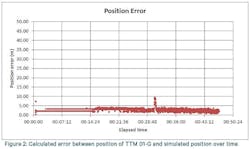The Tekron TTM 01-G GNSS clock was tested in a simulated mobile application at 300 km/h, and found to maintain sub-100 nanosecond timing accuracy, and position accuracy within 10 meters.
By default, Tekron GNSS Clocks are optimized for static timing applications. After completing a site survey, the Clock will enter the ‘position hold’ state, which enables it to maintain accurate timing from few satellites. However, this assumes that the position of the antenna will not change.
Tekron’s TTM 01-G, TSC100 and NTS100 compact GNSS Clocks include support for ‘Mobile GNSS’ mode, in which the Clock does not enter position hold. Instead, the Clock will continually update the position and timing solution, allowing accurate timing even when the receiving antenna is in motion. This allows the Clock to be installed on board a moving vehicle or vessel. Mobile GNSS mode can be enabled by connecting to the Clock using Tekron Clock Configuration Tool 4.1.1.2 or later and selecting the Mobile GNSS checkbox on the GNSS tab.
Following are the results obtained from testing Mobile GNSS mode using a Tekron TTM 01-G. A GNSS simulator was used to simulate a moving antenna at speeds up to 300 km/h, during which the time output accuracy and position output accuracy were measured.
Test Details
The GNSS simulator was used to play back an artificially generated scenario that is initially stationary, then accelerates to 300 km/h, turns right, then decelerates to a stop. The scenario is approximately 47 minutes long.
The GNSS simulator was referenced to a Tekron TCG 02-G GNSS Clock fitted with Rubidium oscillator. The offset of the pulse per second output of the TTM 01-G was measured relative to the pulse per second output of the TCG 02-G by an oscilloscope, and recorded to a PC.
The TTM 01-G was fitted with the RS-232 Serial Strings optional output, which was configured to output the NMEA RMC string, which contains position coordinates. This string was recorded, and the coordinates compared to those simulated by the GNSS simulator.
Test Results
The timing accuracy of the TTM 01-G remained within ± 40 ns of the reference throughout the test scenario, as shown in Figure 1.




